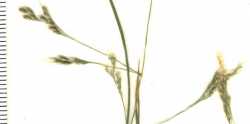|
|
 Spikelets Arizona State University Vascular Plant Herbarium, Usage Rights: Non-Commercial (CC BY-NC) | | | | | |
|
| | |
Origin: Native Season: Warm
Habitat Description: Open woodlands, rocky slopes, and creek banks.
Plant Communities:Interior Chaparral, Semidesert Grasslands, Pinyon Juniper Woodland, Riparian
Elevation: 2000 - 7000 feet
Desc:
Loosely tufted and erect bunchgrass.
Identification Notes: Loosely tufted; blades less than 1/16 inch wide, rough, mostly basal; ligules truncate 1/16 inch long; spikelets less than 1/8 inch long; lemmas hairless; seedheads densely tufted, open at maturity; small, dorsally compressed florets; appressed pedicels.
Grass Type: Perennial bunchgrass Rhizomes: N Stolons: N
Large Dense Clump (> 2 feet): N Bushy (highly branched): N
Height with Seedheads: 24 to 36 inches
Seedhead Structure: Branched - open and spreading Seedhead Droops: N
Flowering Period: Jun - Aug
Number of Flowers per Spikelet: One-flowered Spikelets One-sided: N
Awns: 1/4 inch to 1 inch Three Awns: N Awns Bent: Y
Flower and Seedhead Notes: Seedheads 2 to 8 inches, lower nodes with 1 to 3 branches. Florets 1/16 inch, dorsally compressed; lemmas usually hairless, sometimes having short hairs; shiny, 5-veined, margins not overlapping; awns 1/4 to 1/2 inch, weakly bent and deciduous.
Blade Hairy:
N
Blade with White Margins:
N
Blade Cross section:
Flat or involute
Blade Notes:
Blades 2 to 6 inches long, 1/16 inch wide, usually rolled inward (involute).
Sheath Hairy:
N
Tuft of Hairs at top of Sheath or Collar:
N
Ligules:
Membranous
Auricles (Ear-like lobes at collar area:
N
Forage Value:
Highly palatable to cattle and horses; moderately palatable to sheep, elk and deer.
|
|